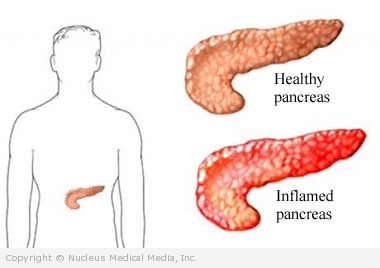(Chronic Pancreatitis; Acute Pancreatitis)
Pancreatitis – Definition
Pancreatitis is a disease in which the pancreas becomes inflamed. The pancreas is a long, flat, pear-shaped organ located behind the stomach. It makes digestive enzymes and hormones, including insulin. In pancreatitis, the digestive enzymes attack the tissue that produces them.
- Acute pancreatitis — occurs suddenly, with severe upper abdominal pain (This can be a serious, life-threatening illness if not treated.)
- Chronic pancreatitis — a progressive disorder that can destroy the pancreas
Pancreatitis – Causes
Causes of pancreatitis include:
- Alcohol abuse (most common cause)
- Gallstones and other obstructions
- Surgery or trauma to the pancreas
- Certain medicines
- Unknown causes (approximately 15% of cases)
- Elevated blood triglyceride levels (hypertriglyceridemia)
- Infections
- HIV infection
- A defective pancreas duct (pancrease divisum)
- Complication of ERCP (endoscopic retrograde cholangiopancreatography)
Pancreatitis – Risk Factors
A risk factor is something that increases your chance of getting a disease or condition. Risk factors for pancreatitis include:
- Alcohol abuse
- Family history of pancreatitis
- Personal history of previous acute pancreatitis
- Medicines, including:
- Estrogens
- Sulfonamides
- Tetracyclines
- Thiazides
- Pancreatic cancer
- Hyperlipidemia (excessive levels of fat in the blood)
- Hypercalcemia (increased calcium in the blood)
- Viral infections, such as mumps
Pancreatitis – Symptoms
Symptoms include:
- Severe pain in the center of the upper abdomen that:
- Sometimes spreads into the upper back
- Is often made worse by eating, walking, or lying down on your back
- Is less severe in chronic pancreatitis, with a gradual onset that may be tolerable for weeks
- Nausea and vomiting
- Diarrhea
- Fever
- Jaundice (yellowing of the skin)
- Shock — a severe change in the body’s vital tasks (eg, rapid but weak pulse, rapid and shallow respiration, and low blood pressure) (in severe, acute cases)
- Unexplained weight loss
- Symptoms of diabetes:
- Increased thirst
- Increased urination
- Fatigue
Pancreatitis – Diagnosis
The doctor will ask about your symptoms and medical history. Your doctor will ask how much alcohol you drink and what medicines you take. A physical exam will be done.
Other tests may include:
- Blood tests — to measure levels of certain digestive enzymes and check for obstructions and complications of pancreatitis (eg, diabetes, kidney failure, infection)
- Abdominal ultrasound or abdominal CT scan — to look for gallstones and determine the level of pancreatic inflammation
- Magnetic resonance cholangiopancreatography (MRCP) — a radiology test ( MRI) that looks at the pancreas, pancreatic duct, and nearby bile ducts
- Endoscopic retrograde cholangiopancreatography (ERCP) — to examine the damage from pancreatitis and diagnose problems related to the pancreatic and biliary ducts
Pancreatitis – Treatment
Acute Pancreatitis
Treatment for acute pancreatitis depends on the severity of the attack. Hospitalization may be necessary. The main goal is to rest the pancreas. In mild cases, this means you may not have food for three to four days. In severe cases, you may not be able to have food for three to six weeks. You will likely need strong pain medicine during this time.
Treatment may also include:
- IV fluids
- IV nutrients if you are unable to eat for an extended period of time
- Antibiotics if you have an infection
- Surgery to drain excess fluid from the abdomen
Chronic Pancreatitis
The goals of treatment for chronic pancreatitis are to relieve pain and manage nutritional and metabolic problems. Specific steps include:
- Strict avoidance of alcohol
- Eating less fat
- Taking pills containing pancreatic enzymes to help with digestion
- Taking insulin to control blood sugar (if diabetes develops)
- Eating smaller meals more frequently
- Taking pain medicine if the pain becomes severe. You may want to see a pain doctor.
Surgery and/or ERCP may be needed to:
- Open a blocked pancreatic or biliary duct
- Remove part (or rarely all) of the pancreas
- Drain pancreatic cysts
If you are diagnosed with pancreatitis, follow your doctor’s instructions.
Pancreatitis – Prevention
The best way to avoid pancreatitis is to limit your intake of alcohol to two drinks or less per day for men and one drink or less per day for women. If you have hyperlipidemia, restrict your intake of fat and follow your doctor’s treatment plan to lower your lipids. Get vaccinated against mumps.

